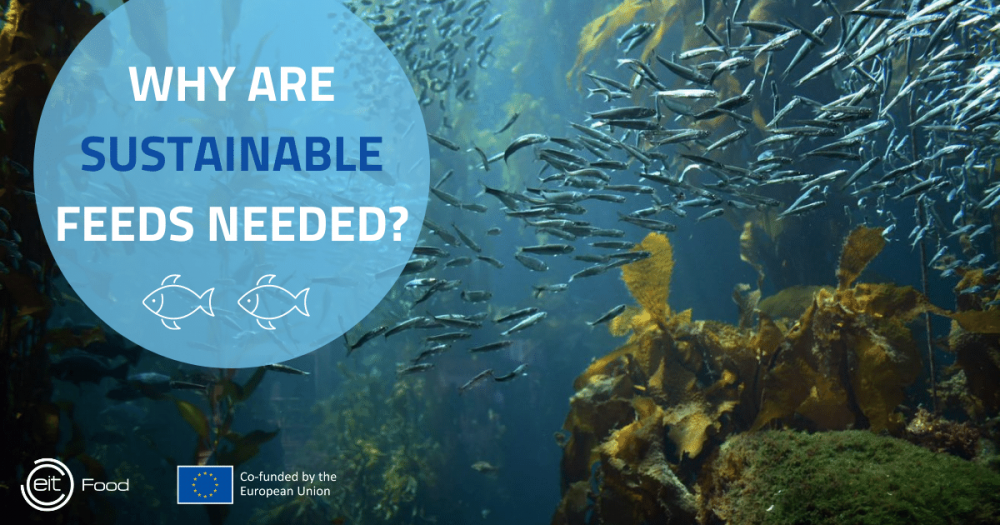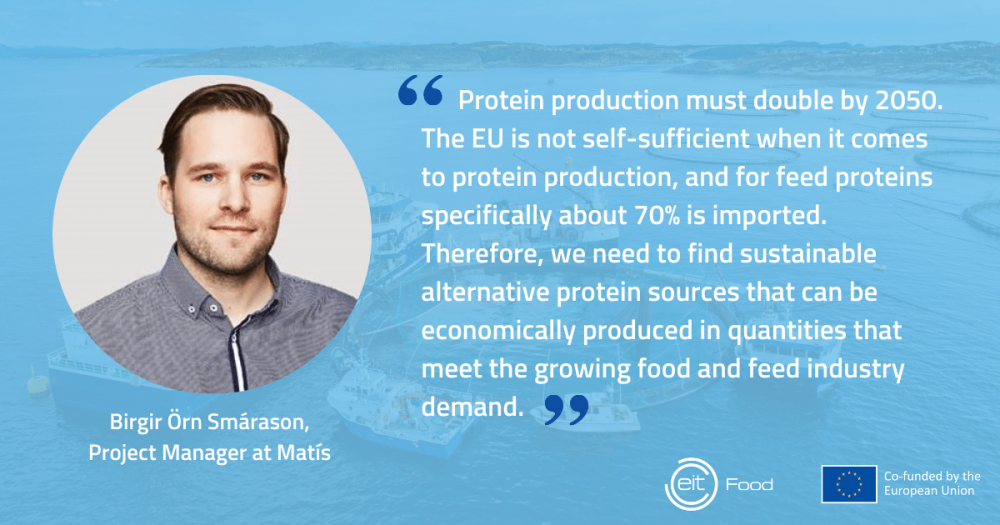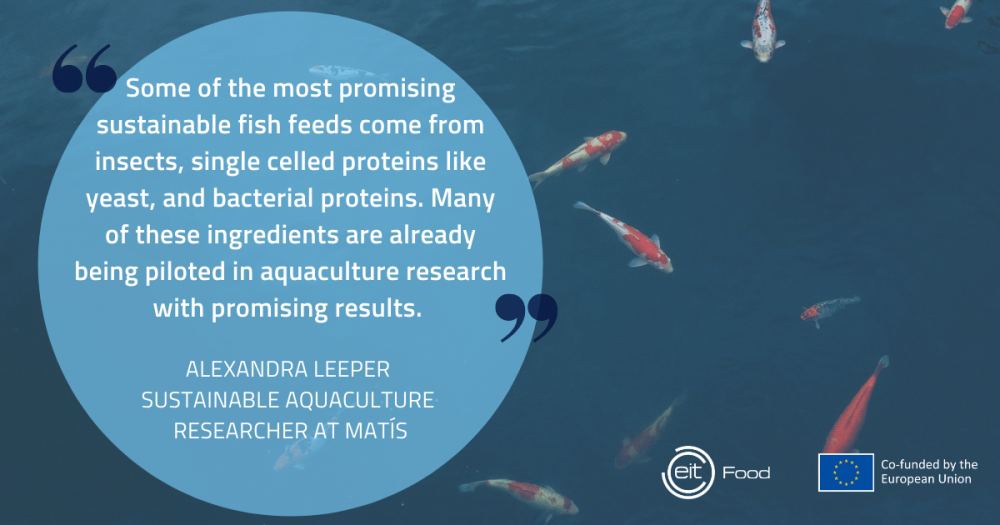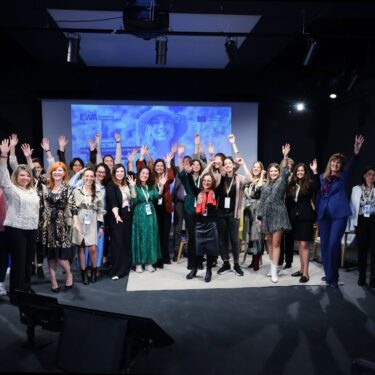Fish feed: Why we need sustainable alternatives

In this edition of our Aquaculture Series we explore the sustainability of current fish feeds and why alternatives are needed. You will learn:
- Why commercial fish feeds can be unsustainable
- What alternative fish feeds already exist and explore others that are in development
- How the EIT Food community is addressing the need for sustainable alternative fish feeds
Why are commercial fish feeds unsustainable?
Currently, commercial fish feeds consist of fishmeal (ground fish) and fish oil. Producing these feeds is resource intensive, as it means that wild-caught fish are caught for feed production. For example, over 69% of fishmeal and 75% of fish oil production is used to feed farmed fish (1).
This has led to forage fish such as anchovies and herring being overfished, and some populations have collapsed. Unfortunately, this has implications for the entire food web since larger fish depend on forage fish for food. In fact, the demand for fish meal and fish oil could surpass the supply of small fish (2), by as early as 2037 (3). This means that industrial feed is not sustainable at a commercial scale in the long term.
As a result, fish feeds must be sustainable to protect marine ecosystems and reduce depletion on ocean resources. However, the demand for commercial fish feed is growing. This is because as the human population continues to rise, the demand for protein increases, and fish is highly demanded because it is an excellent source of protein. A rising global population coupled with a growing demand for protein has led to a ‘protein challenge’.
Birgir Örn Smárason, Project Manager at Matís explains the protein challenge:

As a result, alternative feeds must be able to produce fish that are high in protein.
Why is it important to address the issue of fish feeds?
According to the European Commission’s strategic guidelines for aquaculture, producing fish feeds that are sustainable is vital to the environmental performance of the EU aquaculture sector. Aquaculture - the farming of aquatic animals and plants such as fish, shellfish, seaweed and algae in water environments - is the fastest-growing food industry in the world.
For feed producers, the guidelines advise that feed ingredients should be sourced in a way that respect ecosystems and biodiversity. At the same time, feed ingredients must ensure the health and welfare of the animals themselves. Also, the European Commission state that feed producers should limit reliance on fish meal and fish oil taken from wild stocks. Instead, alternative protein ingredients such as algae or insects or the waste from other industries should be used. You can learn more about the European Commission’s strategic guidelines for aquaculture here.
Importantly, the cost of feed is a significant expense to aquaculture producers, so developing more cost-effective solutions is also important. Alternatives to commercial feeds must be affordable and accessible to aquaculture producers, so they are encouraged and able to use them on their farms. The need to develop sustainable feed products in itself creates an economic opportunity. For example, it can help to develop a new industry that could have high market and societal impact by creating new jobs, thereby improving livelihoods. Therefore, the environment, social and economic impact of developing alternative fish feeds that are sustainable is largely positive.
What examples of alternative fish feeds already exist?
Some alternative feed ingredients include soy and corn-based feeds. However, these ingredients have also been criticised for being unsustainable. For example, soy farming on a large scale requires mass deforestation (4) and causes water pollution (3). Not only that, but fish can also struggle to fully digest soy-based feeds and these feeds can even harm their digestive system over time (4). If indigestible, soy-based feeds can then end up in the aquaculture wastewater which can lead to nutrient pollution (3).
There are other feed ingredient alternatives that are more sustainably sourced. These include plant proteins and oils from plants, yeast, insects, and algae. (5) For example, using oils from algae enables the nutrient requirements of the feed to be maintained without depending on fish oil (5). Another example is farmed seaweed that has significant growth potential as a source of fibre for aquaculture feed.
Insect meal is another alternative ingredient that can be used for fish feed (6) and recent funding in this sector (7) is bringing it closer to commercialisation. For example, a new initiative launched by Cargill (a leading feed producer) is helping salmon farmers to reduce their environmental impact by 30%.

Examples of fish feed innovation in the EIT Food community
EIT Food is addressing some of the challenges and opportunities within the aquaculture sector, to help to transform the sector into a more sustainable one. This includes improving the sustainability of fish feed. For example:
- Matís – an EIT Food Partner is a food and biotech R&D company. They have been active in alternative fish feeds for the last decade mainly in the development, characterization and testing of different alternative proteins sources. Matís has worked with a range of companies on the development and testing of the ingredients in aquaculture for salmonids, shrimp and tilapia.
- Marine Feed – an EIT Food RisingFoodStar is a startup that is developing a 100% organic fish feed. As a sustainable alternative ingredient, ciona meal is cultivated in open water and then harvested in a zero emission circular system. Alternative organic protein sources like ciona meal could help to replace types of fishmeal used in commercial fish feed that are environmentally damaging.
- Development of highly sustainable aquafeeds for European aquaculture – is an EIT Food project led by CSIC that is developing novel feeds for marine fish, to increase the sustainability of European aquaculture. Feeds will be created using by-products from agricultural plant processing and microalgae.
- Ground-breaking Circular Economy Feed Ingredient for Farmed Salmon – is an EIT Food project led by Cewatech. The project is developing a fish feed for salmon that contains protein from recycled wastewater in the starch industry. The fish feed will be made from a sustainable fungi-based protein to replace the use of fishmeal and soybean meal.
What does the future of feed in aquaculture look like?
According to Birgir Örn Smárason, Project Manager at Matís, the future of aquaculture feed is promising:
“We will have an increasingly expanding list of high quality alternative ingredients that are sustainably produced. We will have phased out or at least decreased the share of less sustainable and imported ingredients.”
Do you agree? What do you want the future of feed in aquaculture to look like?
Up next in our EIT Food Aquaculture Series: Can we trust fish from aquaculture - is it safe to eat? Read here
Do you want to learn more about the latest sustainable innovations within the aquaculture sector? Download EIT Food North West's Aquaculture Showcase report here.
Further Reading
- Knowledge Transfer Network (KTN) and EIT Food Report: Innovation opportunities in European Aquaculture
- EIT Food: Can sustainable aquaculture help to achieve the UN SDGs?
- EIT Food: Is farmed fish from aquaculture a healthy source of protein?
- FoodUnfolded: Farming the food chain | Low trophic aquaculture
References
- Compassion in World Farming: Wasteful and unsustainable – the use of wild fish to feed farmed fish
- Froehlich, H.E., Jacobsen, N.S., Essington, T.E. et al. Avoiding the ecological limits of forage fish for fed aquaculture
- The Conversation: Taking fish out of fish feed can make aquaculture a more sustainable food source
- One Green Planet: Why Fish Farming is Unsustainable and Harming the Planet
- NOAA Fisheries: Feeds for Aquaculture
- The Fish Site: The case for supplementing salmon diets with insect meal
- The Guardian: UK insect farm project for sustainable animal feed awarded £10m
More blog posts by EIT Food West

Top women in agrifood to watch

Discover a Day in the Life of a Farm Vet







